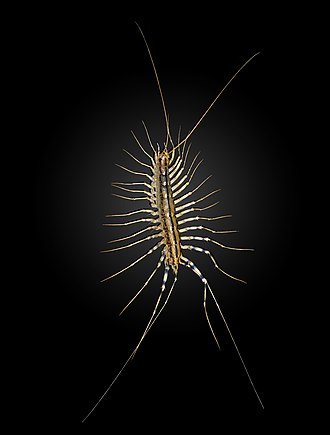Scutigera coleoptrata

Scutigera coleoptrata is a small, typically yellowish-grey centipede with up to 15 pairs of long legs. Originating in the Mediterranean region, the species has spread to other parts of the world, where it can live in human homes, thus gaining the name house centipede.[1] It is an insectivore; it kills and eats other arthropods, such as insects and arachnids.[2]
In 1758, Carl Linnaeus described the species in the tenth edition of his Systema Naturae, giving the name Scolopendra coleoptrata, writing that it has a “coleopterated thorax” (similar to a coleopter).[3] In 1801, Jean-Baptiste Lamarck separated scutigera from scolopendra, calling this species Scutigera coleoptrata.[4] The word scutigera comes from “to bear” (gerere) and “shield” (scutum), because of the shape of the plates in the back of the chilopod.[5]
The body of an adult Scutigera coleoptrata is typically 25 to 35 mm (0.98 to 1.38 in) in length, although larger specimens are sometimes encountered.[6] Up to 15 pairs of long legs are attached to the rigid body. Together with the antennae they give the centipede an appearance of being 75 to 100 mm (3 to 4 in) in length.[6] The delicate legs enable it to reach surprising speeds of up to 0.4 meters per second (1.3 ft/s)[7] running across floors, up walls and along ceilings. Its body is yellowish-grey and has three dark dorsal stripes running down its length; the legs also have dark stripes. S. coleoptrata has developed automimicry in that its tail-like hind legs present the appearance of antennae. When the centipede is at rest, it is not easy to tell its cranial end from its caudal end.
Unlike most other centipedes, house centipedes and their close relatives have well-developed faceted eyes.
House centipedes lay their eggs in spring. In a laboratory observation of 24 house centipedes, an average of 63 and a maximum of 151 eggs were laid. As with many other arthropods, the larvae look like miniature versions of the adult, albeit with fewer legs. Young centipedes have four pairs of legs when they are hatched. They gain a new pair with the first molting, and two pairs with each of their five subsequent moltings. Adults with 15 pairs of legs retain that number through three more molting stages (sequence 4-5-7-9-11-13-15-15-15-15 pairs).[8]
House centipedes live anywhere from three to seven years, depending on the environment. They can start breeding in their third year. To begin mating, the male and female circle around each other. They initiate contact with their antennae. The male deposits his sperm on the ground and the female then uses it to fertilize her eggs.
